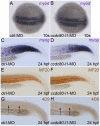Ccdc80-l1 Is involved in axon pathfinding of zebrafish motoneurons
- PMID: 22384085
- PMCID: PMC3285184
- DOI: 10.1371/journal.pone.0031851
Ccdc80-l1 Is involved in axon pathfinding of zebrafish motoneurons
Abstract
Axon pathfinding is a subfield of neural development by which neurons send out axons to reach the correct targets. In particular, motoneurons extend their axons toward skeletal muscles, leading to spontaneous motor activity. In this study, we identified the zebrafish Ccdc80 and Ccdc80-like1 (Ccdc80-l1) proteins in silico on the basis of their high aminoacidic sequence identity with the human CCDC80 (Coiled-Coil Domain Containing 80). We focused on ccdc80-l1 gene that is expressed in nervous and non-nervous tissues, in particular in territories correlated with axonal migration, such as adaxial cells and muscle pioneers. Loss of ccdc80-l1 in zebrafish embryos induced motility issues, although somitogenesis and myogenesis were not impaired. Our results strongly suggest that ccdc80-l1 is involved in axon guidance of primary and secondary motoneurons populations, but not in their proper formation. ccdc80-l1 has a differential role as regards the development of ventral and dorsal motoneurons, and this is consistent with the asymmetric distribution of the transcript. The axonal migration defects observed in ccdc80-l1 loss-of-function embryos are similar to the phenotype of several mutants with altered Hedgehog activity. Indeed, we reported that ccdc80-l1 expression is positively regulated by the Hedgehog pathway in adaxial cells and muscle pioneers. These findings strongly indicate ccdc80-l1 as a down-stream effector of the Hedgehog pathway.
Conflict of interest statement
Figures





Similar articles
-
The Coiled-Coil Domain Containing 80 (ccdc80) gene regulates gadd45β2 expression in the developing somites of zebrafish as a new player of the hedgehog pathway.J Cell Physiol. 2015 Apr;230(4):821-30. doi: 10.1002/jcp.24810. J Cell Physiol. 2015. PMID: 25205658
-
Slow Muscle Precursors Lay Down a Collagen XV Matrix Fingerprint to Guide Motor Axon Navigation.J Neurosci. 2016 Mar 2;36(9):2663-76. doi: 10.1523/JNEUROSCI.2847-15.2016. J Neurosci. 2016. PMID: 26937007 Free PMC article.
-
Pathfinding by zebrafish motoneurons in the absence of normal pioneer axons.Development. 1992 Apr;114(4):825-31. doi: 10.1242/dev.114.4.825. Development. 1992. PMID: 1618146
-
Bidirectional modulation of adipogenesis by the secreted protein Ccdc80/DRO1/URB.J Biol Chem. 2009 Mar 20;284(12):8136-47. doi: 10.1074/jbc.M809535200. Epub 2009 Jan 13. J Biol Chem. 2009. PMID: 19141617 Free PMC article.
-
Motoneuronal development in the embryonic zebrafish.Dev Suppl. 1991;Suppl 2:141-7. Dev Suppl. 1991. PMID: 1842352 Review.
Cited by
-
The function of FAK/CCDC80/E-cadherin pathway in the regulation of B16F10 cell migration.Oncol Lett. 2018 Oct;16(4):4761-4767. doi: 10.3892/ol.2018.9159. Epub 2018 Jul 17. Oncol Lett. 2018. PMID: 30214608 Free PMC article.
-
A novel association of CCDC80 with gestational diabetes mellitus in pregnant women: a propensity score analysis from a case-control study.BMC Pregnancy Childbirth. 2020 Jan 28;20(1):53. doi: 10.1186/s12884-020-2743-3. BMC Pregnancy Childbirth. 2020. PMID: 31992220 Free PMC article.
-
Nexmifa Regulates Axon Morphogenesis in Motor Neurons in Zebrafish.Front Mol Neurosci. 2022 Mar 31;15:848257. doi: 10.3389/fnmol.2022.848257. eCollection 2022. Front Mol Neurosci. 2022. PMID: 35431796 Free PMC article.
-
Comparative Transcriptome Analysis Identifies CCDC80 as a Novel Gene Associated with Pulmonary Arterial Hypertension.Front Pharmacol. 2016 Jun 7;7:142. doi: 10.3389/fphar.2016.00142. eCollection 2016. Front Pharmacol. 2016. PMID: 27375481 Free PMC article.
-
Olfactory ensheathing cells from adult female rats are hybrid glia that promote neural repair.Elife. 2025 Apr 29;13:RP95629. doi: 10.7554/eLife.95629. Elife. 2025. PMID: 40297980 Free PMC article.
References
MeSH terms
Substances
LinkOut - more resources
Full Text Sources
Molecular Biology Databases

